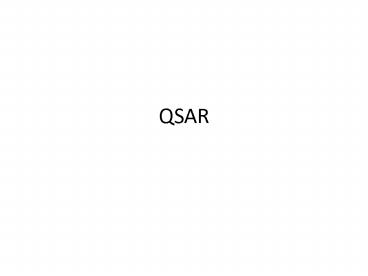QSAR - PowerPoint PPT Presentation
1 / 21
Title:
QSAR
Description:
High hydrophobicity. Activity of drugs is often related to P ... substituent hydrophobicity constant. A measure of a substituent's hydrophobicity relative to ... – PowerPoint PPT presentation
Number of Views:1476
Avg rating:3.0/5.0
Title: QSAR
1
QSAR
2
Introduction
- Aims
- To relate the biological activity of a series of
compounds to their physicochemical parameters in
a quantitative fashion using a mathematical
formula - Requirements
- Quantitative measurements for biological and
physicochemical properties - Physicochemical Properties
- Hydrophobicity of the molecule
- Hydrophobicity of substituents
- Electronic properties of substituents
- Steric properties of substituents
3
Hydrophobicity of the Molecule
4
Hydrophobicity of the Molecule
- Activity of drugs is often related to P
- e.g. binding of drugs to serum albumin
- (straight line - limited range of log P)
- Binding increases as log P increases
- Binding is greater for hydrophobic drugs
5
Hydrophobicity of the Molecule
Example 2 General anaesthetic activity of
ethers (parabolic curve - larger range of log P
values)
Optimum value of log P for anaesthetic activity
log Po
6
Hydrophobicity of the Molecule
- QSAR equations are only applicable to compounds
in the same structural class (e.g. ethers) - However, log Po is similar for anaesthetics of
different structural classes (ca. 2.3) - Structures with log P ca. 2.3 enter the CNS
easily - (e.g. potent barbiturates have a log P of
approximately 2.0) - Can alter log P value of drugs away from 2.0 to
avoid CNS side effects
7
Hydrophobicity of Substituents - the substituent
hydrophobicity constant
- A measure of a substituents hydrophobicity
relative to hydrogen - Tabulated values exist for aliphatic and aromatic
substituents - Measured experimentally by comparison of log Ps
with parent structure
Example
- Positive values imply substituents are more
hydrophobic than H - Negative values imply substituents are less
- hydrophobic than H
8
Hydrophobicity of Substituents - the substituent
hydrophobicity constant
- The value of p is only valid for parent
structures - It is possible to calculate log P using p values
- A QSAR equation may include both P and p.
- P measures the importance of a molecules overall
hydrophobicity (relevant to absorption, binding
etc) - p identifies specific regions of the molecule
which might interact with hydrophobic regions in
the binding site
9
Electronic Effects Hammett Substituent Constant
- The constant (s) a measure of the e-withdrawing
or e-donating influence of substituents - It can be measured experimentally and tabulated
- (e.g. s for aromatic substituents is measured by
comparing the dissociation constants of
substituted benzoic acids with benzoic acid)
10
Hammett Substituent Constant
X electron withdrawing group (e.g. NO2)
Charge is stabilised by X Equilibrium shifts to
right KX gt KH
Positive value
11
Hammett Substituent Constant
X electron donating group (e.g. CH3)
Charge destabilised Equilibrium shifts to left KX
lt KH
Negative value
12
Hammett Substituent Constant
s value depends on inductive and resonance
effects s value depends on whether the
substituent is meta or para ortho values are
invalid due to steric factors
13
Hammett Substituent Constant
EXAMPLES
e-withdrawing (inductive effect only)
e-withdrawing (inductive resonance effects)
14
Hammett Substituent Constant
EXAMPLES
e-withdrawing (inductive effect only)
e-donating by resonance more important than
inductive effect
15
Hammett Substituent Constant (s)
QSAR Equation
Diethylphenylphosphates (Insecticides)
Conclusion e-withdrawing substituents increase
activity
16
Aliphatic electronic substituents
- Defined by sI
- Purely inductive effects
- Obtained experimentally by measuring the rates of
hydrolyses of aliphatic esters - Hydrolysis rates measured under basic and acidic
conditions
Basic conditions Rate affected by steric
electronic factors Gives sI after correction
for steric effect Acidic conditions Rate
affected by steric factors only
17
Steric Factors
Tafts Steric Factor
- Measured by comparing the rates of hydrolysis of
substituted aliphatic esters against a standard
ester under acidic conditions - Es log kx - log ko kx represents the rate of
hydrolysis of a substituted ester - ko represents the rate of hydrolysis of the
parent ester - Limited to substituents which interact sterically
with the tetrahedral transition state for the
reaction - Cannot be used for substituents which interact
with the transition state by resonance or
hydrogen bonding - May undervalue the steric effect of groups in an
intermolecular process (i.e. a drug binding to a
receptor)
18
Steric Factors
Molar Refractivity (MR) - a measure of a
substituents volume
19
Hansch Equation
- A QSAR equation relating various physicochemical
properties to the biological activity of a series
of compounds - Usually includes log P, electronic and steric
factors - Start with simple equations and elaborate as
more structures are synthesised - Typical equation for a wide range of log P is
parabolic
20
Hansch Equation
- Conclusions
- Activity increases if p is ve (i.e. hydrophobic
substituents) - Activity increases if s is negative (i.e.
e-donating substituents)
21
Hansch Equation
Example Antimalarial activity of phenanthrene
aminocarbinols
- Conclusions
- Activity increases slightly as log P
(hydrophobicity) increases (note that the
constant is only 0.14) - Parabolic equation implies an optimum log Po
value for activity - Activity increases for hydrophobic substituents
(esp. ring Y) - Activity increases for e-withdrawing substituents
(esp. ring Y)

